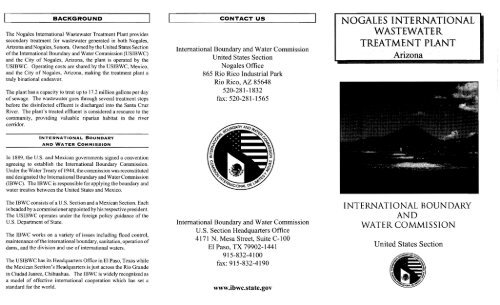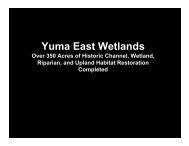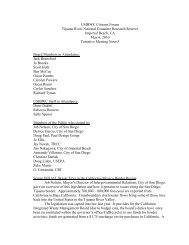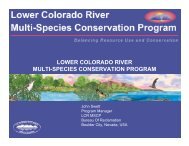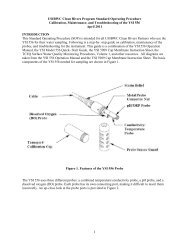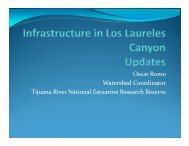Nogales International Wastewater Treatment Plant (NIWTP)
Nogales International Wastewater Treatment Plant (NIWTP)
Nogales International Wastewater Treatment Plant (NIWTP)
You also want an ePaper? Increase the reach of your titles
YUMPU automatically turns print PDFs into web optimized ePapers that Google loves.
BACKGROUND<br />
The <strong>Nogales</strong> <strong>International</strong> <strong>Wastewater</strong> <strong>Treatment</strong> <strong>Plant</strong> provides<br />
secondary treatment for wastewater generated in both <strong>Nogales</strong>,<br />
Arizona and <strong>Nogales</strong>, Sonora. Owned by the United States Section<br />
of the <strong>International</strong> Boundary and Water Commission (USIBWC)<br />
and the City of <strong>Nogales</strong>, Arizona, the plant is operated by the<br />
USIBWC. Operating costs are shared by the USIBWC, Mexico,<br />
and the City of <strong>Nogales</strong>, Arizona, making the treatment plant a<br />
truly binational endeavor.<br />
The plant has a capacity to treat up to 17.2 million gallons per day<br />
of sewage. The wastewater goes through several treatment steps<br />
before the disinfected effluent is discharged into the Santa Cruz<br />
River. The plant's treated effluent is considered a resource to the<br />
community, providing valuable riparian habitat in the river<br />
corridor.<br />
CONTACT US<br />
<strong>International</strong> Boundary and Water Commission<br />
United States Section<br />
<strong>Nogales</strong> Office<br />
865 Rio Rico Industrial Park<br />
Rio Rico, AZ 85648<br />
520-281-1832<br />
fax: 520-281-1565<br />
NOGALES INTERNATIONAL<br />
WASTEWATER<br />
TREATMENT PLANT<br />
Arizona<br />
INTERNATIONAL BOUNDARY<br />
AND WATER COMMISSION<br />
In 1889, the U.S. and Mexican governments signed a convention<br />
agreeing to establish the <strong>International</strong> Boundary Commission.<br />
Under the Water Treaty of 1944, the commission was reconstituted<br />
and designated the <strong>International</strong> Boundary and Water Commission<br />
(IBWC). The IBWC is responsible for applying the boundary and<br />
water treaties between the United States and Mexico.<br />
The IBWC consists of a U.S. Section and a Mexican Section. Each<br />
is headed by a commissioner appointed by his respective president.<br />
The USIBWC operates under the foreign policy guidance of the<br />
U.S. Department of State.<br />
The IBWC works on a variety of issues including flood control,<br />
maintenance of the international boundary, sanitation, operation of<br />
dams, and the division and use of international waters.<br />
The USIBWC has its Headquarters Office in El Paso, Texas while<br />
the Mexican Section's Headquarters is just across the Rio Grande<br />
in Ciudad Juarez, Chihuahua. The IBWC is widely recognized as<br />
a model of effective international cooperation which has set a<br />
standard for the world.<br />
<strong>International</strong> Boundary and Water Commission<br />
U.S. Section Headquarters Office<br />
4171 N. Mesa Street, Suite C-100<br />
El Paso, TX 79902-1441<br />
915-832-4100<br />
fax: 915-832-4190<br />
www.ibwc.state.gov<br />
INTERNATIONAL BOUNDARY<br />
AND<br />
WATER COMMISSION<br />
United States Section
PROJECT HISTORY<br />
1951 PLANT: The adjacent communities of<strong>Nogales</strong>, Arizona and<br />
<strong>Nogales</strong>, Sonora are located in a narrow valley with high hills on<br />
either side. In 1941, the Government of Mexico began preparations<br />
for a sewer system for <strong>Nogales</strong>, Sonora. However, due to urban<br />
development and the slope of the terrain, there was no good site for<br />
a treatment plant on the Mexican side of the border. The two<br />
countries began discussing construction of an international treatment<br />
plant in the United States. In 1945, the IBWC recommended that a<br />
plant be built 1.5 miles north of the border with a capacity of 1.6<br />
million ga11ons per day (mgd). The plant was completed in 1951,<br />
with the costs shared equally between the two countries.<br />
1972 PLANT: As the population grew in both cities, the<br />
communities recognized an urgent need for a larger plant. At the<br />
request of the City of <strong>Nogales</strong>, Arizona, the new plant, with a<br />
capacity of 8.2 mgd, was constructed nine miles north of the<br />
boundary at the confluence of the <strong>Nogales</strong> Wash with the Santa Cruz<br />
River. Construction began in 1970 and was completed in 1972.<br />
The construction cost of the treatment plant was shared by the<br />
United States, Mexico, and the City of <strong>Nogales</strong>, Arizona. The<br />
Mexican participation was based on the cost of enlarging the<br />
treatment plant at the site used for the initial1951 plant. Since the<br />
City of<strong>Nogales</strong>, Arizona required the plant to be located away from<br />
the city limits, additional costs of the pipeline, known as the<br />
<strong>International</strong> Outfall Interceptor, were not borne by Mexico.<br />
t 992 PLANT: In order to comply with more stringent federal and<br />
state regulations, the plant was upgraded in 1992.<br />
FACILITIES<br />
The <strong>Nogales</strong> <strong>International</strong> <strong>Wastewater</strong> <strong>Treatment</strong> <strong>Plant</strong> is located at<br />
the Rio Rico Industrial Park near Interstate 19, nine miles north of<br />
the international boundary. The plant has a dry weather average<br />
daily treatment capacity of 15.75 mgd, with 9.9 mgdofthatcapacity<br />
allocated to Mexico. With the use of additional aerators, the plant<br />
can treat up to 17.2 mgd.<br />
The headworks have two oversized grit settling basins, an automated<br />
screen, manually cleaned bar screen, and two grit pumps. Influent<br />
is routed to two complete mix lagoons using up to 18 surface<br />
aerators/mixers. Following these are eight partial mix lagoons using<br />
up to 16 surface aerators. Treated sewage passes through filters and<br />
is then disinfected with chlorine. Dechlorinated effluent is<br />
discharged into the Santa Cruz River.<br />
Additionally, the plant has an administrative building, laboratory,<br />
electrical panel control room, workshops, storage areas, and other<br />
facilities for project personnel. <strong>Plant</strong> facilities are surrounded by a<br />
perimeter fence and a gate, ensuring that only authorized staff and<br />
visitors are granted access to the site, in recognition of contemporary<br />
security concerns.<br />
OPERATIONS AND MAINTENANCE<br />
From 1972 until 1996, the City of <strong>Nogales</strong>, Arizona operated and<br />
maintained the treatment plant, with oversight provided by the<br />
USIBWC. A private company under contract to the USIBWC<br />
operated the plant for the next two years. Since October 1, 1998, the<br />
U.S. Section has operated the plant with its own personnel. Mexico<br />
and the City of <strong>Nogales</strong>, Arizona reimburse the USIBWC for their<br />
share of treatment costs.<br />
FUTURE PLANS<br />
Due to expected growth on both sides of the border and in order to<br />
meet more stringent treatment standards, work is underway to<br />
upgrade theN ogales <strong>International</strong> <strong>Wastewater</strong> <strong>Treatment</strong> <strong>Plant</strong>. The<br />
project also includes work on the <strong>International</strong> Outfall Interceptor,<br />
which conveys sewage from the border to the treatment plant.<br />
Implementation of the project is a collaborative effort of the<br />
<strong>International</strong> Boundary and Water Commission and the City of<br />
<strong>Nogales</strong>, Arizona.<br />
OTHER PROJECTS<br />
The <strong>Nogales</strong> Project Office has responsibility for other activities<br />
along the eastern part of the Arizona-Sonora border, including<br />
boundary demarcation. The IBWC is responsible for maintaining<br />
hundreds of monuments and markers that denote the official location<br />
of the international land boundary. The IBWC has also been<br />
involved in sanitation work at Naco, Sonora.<br />
Additionally, the IBWC<br />
has provided for the<br />
disinfection of sewage<br />
in <strong>Nogales</strong> Wash, a<br />
storm drain that flows<br />
northward through the<br />
urban areas of <strong>Nogales</strong> ~~~~;,1:;<br />
in both countries. This<br />
effort reduces the public<br />
health risk that occurs<br />
when maintenance<br />
problems cause sewage<br />
to enter the storm drain.<br />
The USIBWC maintains<br />
a second Arizona office<br />
in Yuma, which works<br />
primarily on issues<br />
related to the Colorado<br />
River.<br />
Boundary Demarcation Monument


